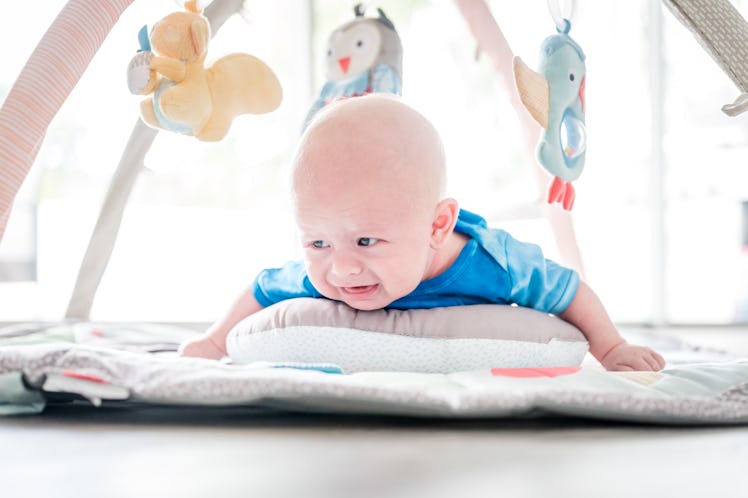Baby Grunting Is A Red Flag No Parent Should Ignore
It may be constipation, but experts say there’s a good chance it could be something much worse.

Parents spend a lot of bandwidth monitoring how their baby eats, sleeps, and poops. At least for a time, life revolves around those activities, and keeping them in rhythm is a constant challenge. So it’s understandable that when babies show signs of distress, parents tend to assume one of those primary functions is the culprit. But some infant distress signals, such as a baby or newborn grunting a lot, indicate other health issues that are far more serious.
When it comes to persistent baby grunting and straining but not pooping, pediatric emergency physician and Senior Medical Advisor at PM Pediatric Care Christina Johns, M.D., warns that constipation is likely not the cause. Rather, it can be a sign of respiratory distress.
“Persistent grunting is a symptom that’s regularly misinterpreted,” Johns says. “When I get a call from a triage nurse who says we have a grunting baby, I run — I don't walk — to those to ensure that we don't have impending respiratory failure.”
When Is Baby Grunting A Sign Of Respiratory Distress?
Babies who have trouble breathing grunt because they exert a higher-than-typical amount of energy toward breathing. That overexertion is the same core reason they grunt when they have difficulty pooping or when an adult grunts while lifting heavy furniture.
But when babies have trouble breathing, there are some accompanying signs that parents should pay attention to. “The tells can be very subtle. In babies, respiratory distress is often associated with nasal flaring, which is not something we see when a baby is constipated or starting a bowel movement,” Johns says.
She encourages parents to consider the broader context of their infant’s health when looking at symptoms. There’s a much higher likelihood that grunting is a sign of respiratory distress if the baby is — or has recently been — sick with influenza, RSV, or another respiratory illness.
Feedings are also a struggle for babies laboring to breathe — another sign that you should seek professional help immediately.
Although most people recognize that a person’s face turning blue is a sign of oxygen deprivation, Johns emphasizes that kids can be in a state of oxygen deprivation without their skin changing color. By the time a person’s skin starts to change color, it’s already a full-blown emergency, she says.
“It's important to know that cyanosis, which is when a lack of oxygen causes a child’s skin to get paler or blue, is a very late finding. So if I see a kid in the emergency room who looks blue, gray, or totally, totally pale, I'm getting out my whole resuscitation cart,” Johns says.
None of this is to say that babies never grunt when they’re pooping or constipated. Sometimes the digestive tract doesn’t make things easy on a kid. But if you notice your baby grunting, it’s important to look for signs of respiratory distress.
A grunting baby that has its legs drawn up and is getting red in the face is most likely working on completing a bowel movement. And though it might seem counterproductive, a constipated baby will still show interest in feeding, unlike a baby who isn’t getting enough oxygen.
How Is Respiratory Distress In Babies Treated?
When a medical provider suspects a baby is having trouble breathing, they act with urgency. That can seem scary, but Johns says parents should know that medical facilities have the tools to hone in on a diagnosis and provide treatment that can typically improve oxygen levels in short order.
“Parents can expect their child to be placed immediately on a monitor,” Johns says. “Not the thing that clips on your finger to check the oxygen saturation, but ongoing full cardiorespiratory monitoring, and likely immediate supplemental oxygen.” This usually alleviates immediate oxygen deficiency and allows doctors to pinpoint causes and possible treatments.
“I want to identify the components that might help me diagnostically,” she says. “For instance, I’ll listen to the lungs to determine if the child is wheezing, which will help me determine if they need a bronchodilator nebulizer treatment.” Physicians tend to be cautious and thorough in such situations.
Johns hopes she can continue to educate parents about signs of respiratory distress so they can better identify the issue and seek treatment for their kids.
“Every single year, we see multiple kids come in whose parents think they are constipated, but they’re actually having trouble breathing,” Johns says. “It’s a very common misperception, and it’s not really anyone's fault. So in the best interest of everyone, I just want to continue to raise awareness without any kind of judgment.”
This article was originally published on